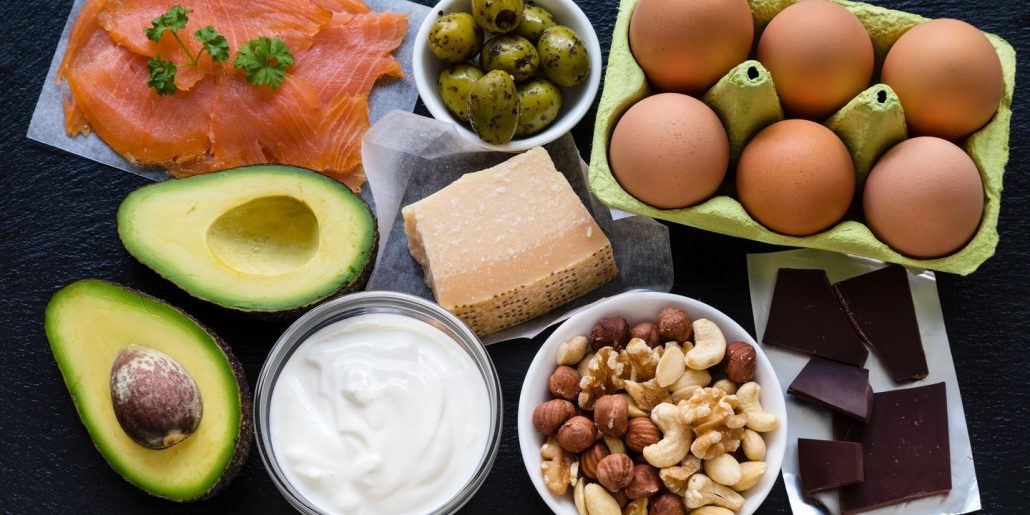The keto diet has become one of the most popular methods today to shed excess weight and improve health.
Therefore, if you find yourself in a conversation about dieting or losing weight, chances are you’ll hear the word keto. Research has demonstrated that adopting to this low-carb, high-fat eating style can promote rapid fat loss and even improve certain health conditions such as type 2 diabetes and cognitive decline. (1, 2)
In this article I will breakdown what type of foods to eat and which ones you need to avoid while following a ketogenic diet.
Keto Basics
The keto diet, as a rule, is very low in carbs, high in fat and moderate in protein. When following a ketogenic diet, carbs are typically reduced to under 50 grams per/day, though stricter and looser versions of the diet do exist. (3)
Fats should replace the majority of cut carbs and deliver approximately 75 percent of your total daily calories. Proteins should account for around 20 percent of energy needs, while carbs are usually restricted to 5 percent or less.
This carb reduction forces your body to rely on fats for its main energy source instead of glucose, a metabolic state known as ketosis.
While in ketosis, your body uses ketones —molecules produced in the liver from fats when glucose is limited — as an alternate fuel source.
Although fat is often avoided for its high calorie content, research shows that ketogenic diets are significantly more effective at promoting weight loss than low-fat diets. Plus, keto diets reduce hunger and increase satiety, which can be particularly helpful when trying to lose weight. (4, 5)
Switching over to a ketogenic diet can seem overwhelming, but it doesn’t have to be difficult. Your focus should be on reducing carbs while increasing the fat and protein content of meals and snacks.
In order to reach and remain in a state of ketosis, carbs must be restricted. And while certain people might only achieve ketosis by eating less than 20 grams of carbs per day, others may be successful with a much higher carb intake. Generally though, the lower your carbohydrate intake, the easier it is to reach and stay in a state of ketosis.
This is why sticking to keto friendly foods and avoiding carbohydrate rich food is essential to successfully weight loss on a ketogenic diet.
Keto-Friendly Foods
When following a ketogenic diet, meals and snacks should center around these following foods:
- Eggs: Pastured, organic whole eggs make the best choice.
- Poultry: Chicken and turkey.
- Fatty fish: Wild-caught salmon, herring, tuna and mackerel.
- Meat: Grass-fed beef, venison, pork, organ meats and bison.
- Full-fat dairy: Yogurt, butter, ghee and cream.
- Full-fat cheese: Cheddar, mozzarella, brie, goat cheese and cream cheese.
- Nuts and seeds: Macadamia nuts, almonds, walnuts, pumpkin seeds, peanuts and flaxseeds.
- Nut butter: Natural peanut, sunflower, almond and cashew butters.
- Healthy fats: Coconut oil, olive oil, avocado oil, macadamia oil and coconut butter.
- Avocados: Whole avocados can be added to almost any meal or snack.
- Non-starchy vegetables: Greens, broccoli, tomatoes, mushrooms and peppers.
- Condiments: Salt, pepper, vinegar, lemon juice, fresh herbs and spices.
Foods to Avoid
The following foods should be restricted:
- Bread and baked goods: White bread, whole-wheat bread, crackers, cookies, doughnuts and rolls.
- Sweets and sugary foods: Sugar, ice cream, candy, maple syrup, agave nectar and coconut sugar.
- Sweetened beverages: Soda, juice, sweetened teas and sports drinks.
- Pasta: Spaghetti and noodles.
- Grains and grain products: Wheat, rice, oats, breakfast cereals and tortillas.
- Starchy vegetables: Potatoes, sweet potatoes, butternut squash, corn, peas and pumpkin.
- Beans and legumes: Black beans, chickpeas, lentils and kidney beans.
- Fruit: Citrus, grapes, bananas and pineapple.
- High-carb sauces: Barbecue sauce, ketchup, sugary salad dressings and dipping sauces.
- Certain alcoholic beverages: Beer and sugary mixed drinks.
Though carbs should be restricted, low-glycemic fruits such as berries can be enjoyed in limited amounts as long as you’re maintaining a keto-friendly macronutrient range.
Be sure to choose healthy food sources and steer clear of processed foods and unhealthy fats.
The following items should be avoided:
- Unhealthy fats: Margarine, shortening and vegetable oils such as canola and corn oil.
- Processed foods: Fast food, packaged foods and processed meats such as hot dogs and lunch meats.
- Diet foods: Foods that contain artificial colors, preservatives and sweeteners such as sugar alcohols and aspartame.
Keto-Friendly Beverages
Sugar can be found in a wide variety of beverages including juice, soda, iced tea and coffee drinks. While on a ketogenic diet, high-carb drinks must be avoided just like high-carb foods. It’s no small matter that sugary beverages have also been linked to various health issues, from obesity to an increased risk of diabetes. (6, 7, 8)
Thankfully, there are many tasty, sugar-free options for those on the keto diet.
Keto-friendly beverage choices include:
- Water: Water is the best choice for hydration and should be consumed throughout the day.
- Sparkling water: Sparkling water can make an excellent soda replacement.
- Unsweetened coffee: Try heavy cream to add flavor to your cup of joe.
- Unsweetened green tea: Green tea is delicious and provides many health benefits.
If you want to add some extra flavor to your water, try experimenting with different keto-friendly flavor combinations. For example, tossing some fresh mint and lemon peel into your water bottle can make hydration a breeze.
And although alcohol should be restricted, enjoying a low-carb drink like vodka or tequila mixed with soda water is perfectly fine on occasion.
Keto-Friendly Snack Options
Snacking between meals can help moderate hunger and keep you on track while following a ketogenic diet. Because the ketogenic diet is so filling, you may only need one or two snacks per day, depending on your activity level.
Here are some excellent, keto-friendly snack options:
- Almonds and cheddar cheese
- Guacamole with low-carb veggies
- Hard-boiled eggs
- Coconut chips
- Kale chips
- Olives
- Celery and peppers with cream cheese dip
- Berries with heavy whipping cream
- Jerky
- Cheese roll-ups
- Macadamia nuts
- Greens with high-fat dressing and avocado
- Keto smoothie made with coconut milk, cocoa and avocado
- Avocado cocoa mousse
Although these Keto-friendly snacks can help you maintain fullness between meals, they can also contribute to weight gain if you’re over snacking throughout the day. So, just remember to use these snacks moderately.
Keto-Friendly Shopping List
A well-rounded ketogenic diet should include lots of fresh produce, healthy fats and proteins. Choosing a mixture of both fresh and frozen produce will ensure that you have a supply of keto-friendly vegetables and fruits to add to recipes.
The following is a simple ketogenic shopping list that can guide you when perusing the grocery aisles:
- Meat and poultry: Beef, chicken, turkey and pork (choose organic, pasture-raised options whenever possible).
- Fish: Fatty fish like salmon, sardines, mackerel and herring are best.
- Shellfish: Oysters, shrimp and scallops.
- Eggs: Purchase omega-3-enriched or pastured eggs whenever possible.
- Full-fat dairy: Unsweetened yogurt, butter, heavy cream and sour cream.
- Oils: Coconut and avocado oils.
- Avocados: Buy a mixture of ripe and unripe avocados so that your supply will last.
- Cheese: Brie, cream cheese, cheddar and goat cheese.
- Frozen or fresh berries: Strawberries, raspberries, blackberries.
- Nuts: Macadamia nuts, almonds, pecans, pistachios.
- Seeds: Pumpkin seeds, sunflower seeds, chia seeds.
- Nut butters: Almond butter, peanut butter.
- Fresh or frozen low-carb vegetables: Mushrooms, cauliflower, broccoli, greens, peppers, onions and tomatoes.
- Condiments: Sea salt, pepper, salsa, herbs, garlic, vinegar, mustard, olives and spices.
It’s always worthwhile to plan your meals ahead of time and fill your cart with the ingredients needed for a few days’ worth of healthy dishes. Plus, sticking to a shopping list can help you avoid tempting, unhealthy foods.
The Bottom Line
A healthy ketogenic diet should consist of about 75 percent fat, 20 percent protein and only 5 percent or less than 50 grams of carbs per day, preferable closer to 20 grams.
Focus on high-fat, low-carb foods like eggs, meats, full-fat dairy and low-carb vegetables, as well as sugar-free beverages. Additionally, be sure to restrict highly processed items and unhealthy fats.
The popularity of the ketogenic diet has made it easier than ever to find a wide selection of interesting and healthy keto meal ideas online.
Although keto is not for everyone, if you’re planning to try the ketogenic diet than using this article can help you transition to it a little more mindful and comforting.


